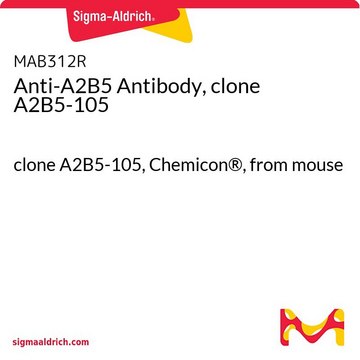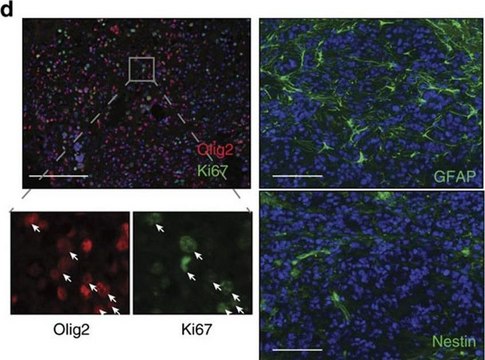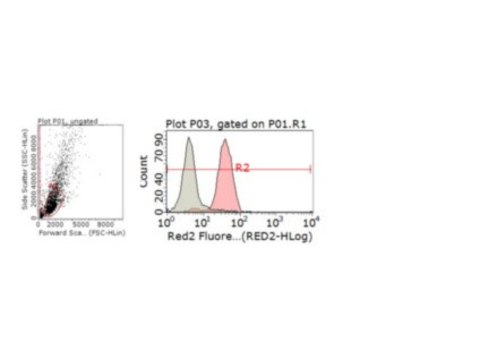MAB312
Anti-A2B5 Antibody, clone A2B5-105
clone A2B5-105, Chemicon®, from mouse
Synonyme(s) :
Neuron Cell Surface Antigen
About This Item
Produits recommandés
Source biologique
mouse
Niveau de qualité
Forme d'anticorps
purified antibody
Type de produit anticorps
primary antibodies
Clone
A2B5-105, monoclonal
Réactivité de l'espèce (prédite par homologie)
mammals
Fabricant/nom de marque
Chemicon®
Technique(s)
flow cytometry: suitable
immunocytochemistry: suitable
immunofluorescence: suitable
immunohistochemistry: suitable
Isotype
IgM
Conditions d'expédition
wet ice
Modification post-traductionnelle de la cible
unmodified
Spécificité
Immunogène
Application
Using double immunofluorescence the GQ ganglioside has a similar distribution on neurons to the D2 protein, to the tetanus toxin receptor and to neurofilaments (Walsh, 1980).
May also be used in the depletion of neurons for a mixed population or their purification by affinity chromatography.
May also be useful for detecting the metastatic spread of neuroblastoma cells into bone marrow.
Flow cytometry: live cells {Maric, D. et al. (2000) Cerebral Cortex 10:729-747}.
Immunohistochemistry: Frozen, fixed tissues (Levison & McCarthy, 1989)
Complement-mediated cytotoxicity (Eisenbarth et al., 1979)
Optimal working dilutions must be determined by end user.
Neuroscience
Neuronal & Glial Markers
Forme physique
Stockage et stabilité
Remarque sur l'analyse
Type II astrocytes, human neural progenitors
Autres remarques
Informations légales
Clause de non-responsabilité
Vous ne trouvez pas le bon produit ?
Essayez notre Outil de sélection de produits.
Code de la classe de stockage
10 - Combustible liquids
Classe de danger pour l'eau (WGK)
WGK 2
Point d'éclair (°F)
Not applicable
Point d'éclair (°C)
Not applicable
Certificats d'analyse (COA)
Recherchez un Certificats d'analyse (COA) en saisissant le numéro de lot du produit. Les numéros de lot figurent sur l'étiquette du produit après les mots "Lot" ou "Batch".
Déjà en possession de ce produit ?
Retrouvez la documentation relative aux produits que vous avez récemment achetés dans la Bibliothèque de documents.
Notre équipe de scientifiques dispose d'une expérience dans tous les secteurs de la recherche, notamment en sciences de la vie, science des matériaux, synthèse chimique, chromatographie, analyse et dans de nombreux autres domaines..
Contacter notre Service technique








